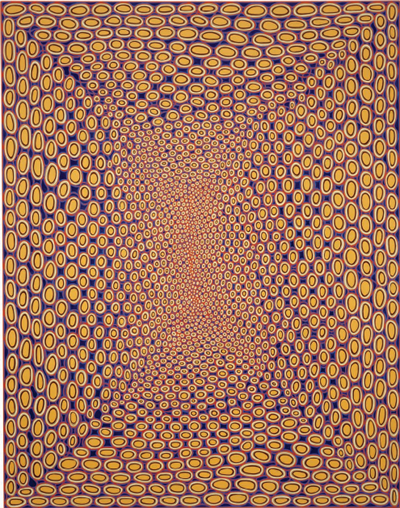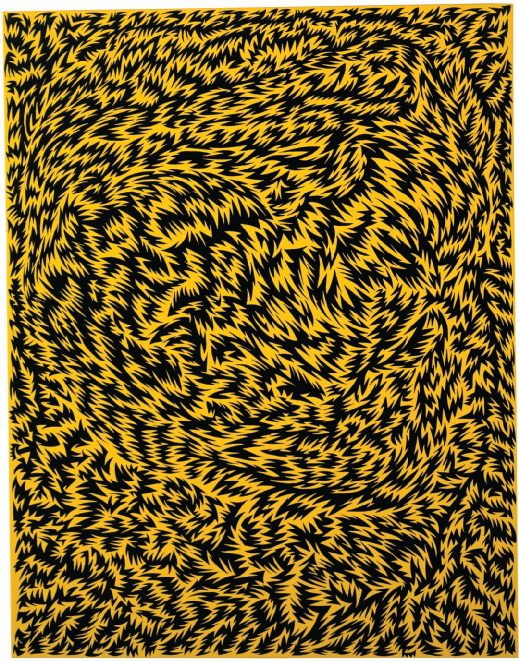 Artist James Siena ’79 has come a long way from his first public show—two paintings on the wall of the Moosewood Restaurant. With his work in major American museums and exhibits at prestigious New York galleries, Siena is at the top of his game. Recently named Cornell’s 2009 Eissner Artist of the Year, Siena is known for his intense enamel-on-metal works, each solving a “problem” he devises for himself.
Artist James Siena ’79 has come a long way from his first public show—two paintings on the wall of the Moosewood Restaurant. With his work in major American museums and exhibits at prestigious New York galleries, Siena is at the top of his game. Recently named Cornell’s 2009 Eissner Artist of the Year, Siena is known for his intense enamel-on-metal works, each solving a “problem” he devises for himself.
By Beth Saulnier

James Siena '79 had his first public art show at a restaurant. But at least it was one of the world's most famous vegetarian eateries: Moosewood, the venerable fixture of Ithaca's Dewitt Mall whose eponymous cookbook brought meatless cuisine to the masses. "I got to put up two pieces," the artist recalls, "and I think I got a free dinner."
Siena has come a long way from that undergrad debut. His work is in the collections of such institutions as the Metropolitan Museum of Art, the MoMA, Boston's Museum of Fine Art, and the San Francisco Museum of Modern Art; he participated in the 2004 Whitney Biennial and has had two solo shows at New York's prestigious PaceWildenstein Gallery. This summer, he got a nod from his alma mater with the 2009 Eissner Artist of the Year Award from the Cornell Council for the Arts; his work will be on display at the Johnson Museum from January to April, and he'll give a talk on campus on April 16. "One of the things I think about when I work is to slow down modern art to some extent," he says, "to take the immediacy of modern life and make it less of a subject."
Artist James Siena '79 has gained fame with his intense geometric paintings, each a 'problem' solvedAlthough Siena also makes prints and drawings, he's best known for his small-scale works on aluminum that, as a New York Times reviewer once noted, "at first resemble funky retro-style patterns for kitchen linoleum or bathroom tile." But in fact, they're the products of Siena's own "algorithms," sets of mathematical and geometric rules he devises as a sort of personal challenge and aesthetic exercise. Those restrictions can be brief and straightforward: "Endless line containing black," he explains in the catalog for a 2001 show, describing a piece called Untitled Yellow-Black. "Line made up of acute angles. No lines may cross each other." Or they can be devilishly complex, as in the Battery series:
Irregular ellipses follow the four sides of the picture and cover the entire surface in a spiral chain. Ellipses are located such that they are not situated beside one another, but beside the space between them. Their size diminishes slightly as they reach the center. Irregular spacing causes a "cascade effect"; that is, the distortions of one area, because of their determinant value to successive ellipses, cause further distortions, which in turn repeat the distortion, until the center is reached. Once the surface is distributed with ellipses, they are lined, within and without, the outer lining taking the form of a net which travels from ellipse to ellipse, forming rectangles with concave sides. . . . All voids are thus filled with successive colors.
"Why do I come up with specific rules?" Siena muses. "I think it's because the picture can kind of make itself—the art would not exist without the idea or rule. It's difficult to say what my goal is, because there's a different goal every time I sit down to make a painting. There's a procedure in motion, and it's the job of that one particular painting to solve that problem. Then when I'm done with that, I go and make another problem. So maybe another way to describe it is that I start a problem and solve it, and the picture is the result of that process."



